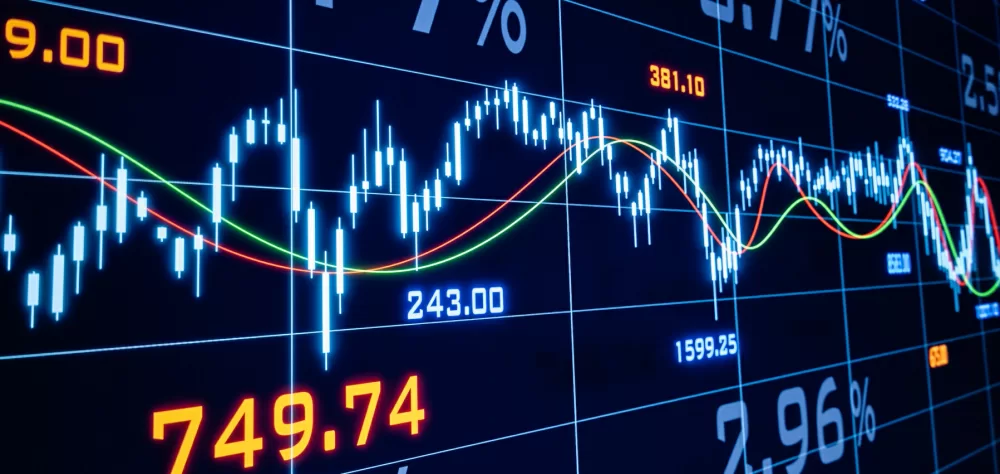Price fluctuations are just a part of investing in securities – or are they? Some investors deliberately seek out the terms “low volatility” or “minimum volatility” when buying shares in stocks and exchange-traded funds (ETFs) in hopes of avoiding fluctuations. This moneyland.ch guide gives you clear and concise answers to the most important questions.
What does low volatility mean?
The term low volatility is used for stocks that have historically shown relatively small fluctuations (volatility). That means the price of the stock has had relatively few charges in the past, and the span of these fluctuations has been small. These stocks should ideally provide stability, which makes them particularly suitable for risk-averse investors.
Important: Stocks and ETFs are classified as having low volatility based entirely on past price performance. But past performance is not a reliable indicator of future price developments and volatility. A low-volatility designation also does not necessarily imply that the stock will gain value in the future. For example, a stock with very low volatility and a price that hardly changes from day to day can lose a great deal of its value over a long period of time.
Are there stock indexes that track low-volatility stocks?
Investors can choose from numerous stock indexes focused on stocks with small fluctuation spans. Most of these are sub-indexes of well-known stock indexes. They include all stocks from the parent index that have an established record of low volatility. The makeup of these indexes is checked and adjusted on a regular basis. In the case of the MSCI indexes, for example, this is done twice per year. Similar sub-indexes based on specific criteria also exist for wide-moat stocks and momentum stocks, among others.
Example: The widely-used global index MSCI World Index has a low-volatility sub-index, the MSCI World Minimum Volatility Index. In simplified terms, this sub-index includes all of the stocks in the MSCI World Index that have, in the past, had lower volatility than the index as a whole. The MSCI World Minimum Volatility ESG Reduced Carbon Target Index has an additional filter, removing low-volatility stocks that do not meet its ESG criteria.
Table 1: Overview of low-volatility stock indexes
| Index |
Number
of stocks |
Stock with the
biggest index
share |
Number
of countries |
Country with the
biggest index
share |
| EURO STOXX Low Risk Weighted 100 |
100 |
KPN (1.77%) |
9 |
Frankreich (33.20%) |
| MSCI Emerging Markets Low Volatility Index |
338 |
Bharti Airtel (1.74%) |
24 |
Indien (25.23%) |
MSCI World Minimum Volatility ESG Reduced
Carbon Target Index |
219 |
IBM (1.76%) |
23 |
USA (65.61%) |
| MSCI World Minimum Volatility Index |
262 |
T-Mobile US (1.73%) |
23 |
USA (65.58%) |
| S&P 500 Minimum Volatility Index |
75 |
Cisco Systems (3.07%)* |
1 |
USA (100%) |
*Weighting according to iShares Edge S&P 500 Minimum Volatility UCITS ETF
Date: 07.10.2024. Source: Index publishers.
At this point in time (October 2024), there are no indexes that only track Swiss low-volatility stocks. However, the MSCI World Minimum Volatility Index includes a number of Swiss companies, including some of the biggest stocks included in the SMI (see Table 2).
Table 2: Swiss stocks included in the MSCI World Minimum Volatility Index
| Company |
ISIN |
Sector |
Headquarters |
| BKW |
CH0130293662 |
Energy |
Bern |
| Chubb |
CH0044328745 |
Insurance |
Zurich |
| Ems Chemie |
CH0016440353 |
Chemicals |
Domat/Ems |
| Givaudan |
CH0010645932 |
Flavoring, fragrances |
Vernier |
| Logitech |
CH0025751329 |
Electronics, computer peripherals |
Lausanne |
| Nestlé |
CH0038863350 |
Food processing, consumer goods |
Vevey |
| Novartis |
CH0012005267 |
Pharmaceuticals |
Basel |
| Roche |
CH0012032048 |
Pharmaceuticals |
Basel |
| Schindler |
CH0024638212 |
Elevators, escalators |
Hergiswil |
| SGS |
CH1256740924 |
Inspection, certification |
Geneva |
| Swisscom |
CH0008742519 |
Telecom |
Bern |
| Swiss Re |
CH0126881561 |
Insurance |
Zurich |
| Zurich Insurance Group |
CH0011075394 |
Insurance |
Zurich |
Date: October 7, 2024. Source: Xtrackers MSCI World Minimum Volatility UCITS ETF 1C.
Can I use ETFs to invest in low-volatility stocks?
Yes. There are many different ETFs that replicate low-volatility indexes. By buying shares in an ETF, you invest in all of the stocks tracked by the underlying stock index, without having to buy shares in individual stocks. The ongoing fees charged by ETF managers – the total expense ratio (TER) – are usually low. You can buy shares in an ETF at any time during trading hours using a stockbroker. All you need is a stock brokerage account.
Table 3: ETFs that replicate low-volatility stock indexes
| ETF |
ISIN |
Fund
domicile |
TER |
Dividends |
Replication |
| EURO STOXX Low Risk Weighted 100 |
SPDR EURO STOXX
Low Volatility UCITS ETF |
IE00BFTWP510 |
Ireland |
0.30% |
Accumulating |
Physical |
| MSCI Emerging Markets Low Volatility Index |
iShares Edge MSCI EM
Minimum Volatility UCITS ETF |
IE00B8KGV557 |
Ireland |
0.40% |
Accumulating |
Sampling |
| MSCI World Minimum Volatility ESG Reduced Carbon Target Index |
iShares Edge MSCI World
Minimum Volatility ESG
UCITS ETF CHF Hedged (Acc) |
IE00BMH5T269 |
Ireland |
0.35% |
Accumulating |
Sampling |
| MSCI World Minimum Volatility Index |
Xtrackers MSCI World
Minimum Volatility UCITS ETF 1C |
IE00BL25JN58 |
Ireland |
0.25% |
Accumulating |
Sampling |
iShares Edge MSCI World
Minimum Volatility
UCITS ETF USD (Acc) |
IE00B8FHGS14 |
Ireland |
0.30% |
Accumulating |
Sampling |
| S&P 500 Low Volatility Index |
iShares Edge S&P 500
Minimum Volatility
UCITS ETF (Acc) |
IE00B6SPMN59 |
Ireland |
0.20% |
Accumulating |
Sampling |
iShares Edge S&P 500
Minimum Volatility
UCITS ETF (Dist) |
IE00BD93YH54 |
Ireland |
0.20% |
Distributing |
Sampling |
iShares Edge S&P 500
Minimum Volatility
UCITS ETF (EUR hedged) |
IE00BYX8XD24 |
Ireland |
0.25% |
Accumulating |
Sampling |
Daten gemäss Anbietern und justetf.com. Stand: 07.10.2024.
In addition to the ongoing fees charged by the fund itself (the TER), there are other costs to pay attention to. Your stock broker may charge your brokerage fees to buy and sell shares, and custody fees to hold shares. These fees vary between stock brokers. That is why it is worth it to compare stock brokers on moneyland.ch. Additionally, you pay Swiss stamp duties levied by the government, which are identical across all Swiss stock brokers.
What are the disadvantages and risks of low-volatility ETFs?
As a general rule, investing in securities always comes with a risk of loss. That also applies to ETFs and stocks that have had very minimal price fluctuations in the past. Additionally, there are some other disadvantages that are specific to low-volatility ETFs:
- Less diversification: Indexes that only track stocks with low volatility deliberately exclude numerous stocks that do not match their criteria. The result is that these indexes are numerically less diversified than standard global indexes. The MSCI World Minimum Volatility Index, for example, only tracks 262 stocks, compared to the 1400 stocks tracked by its parent index (as per September 2024). The number of industry sectors included is also lower, with less volatile sectors like consumer goods and telecom being strongly represented, while more volatile sectors like technology are excluded.
- Opportunity costs: Riskier sectors like technology and artificial intelligence often provide opportunities for substantial returns – although gains are not guaranteed. These sectors are only moderately represented in low-volatility indexes, or are not represented at all. Investors who shy away from volatility relinquish a lot of profit potential.
How profitable are low-volatility stocks?
It is impossible to know in advance how well or poorly stocks will perform in the future. Even past returns are not a reliable indicator of future price developments.
In the past, an ETF that invests in the standard MSCI World Index delivered higher returns for investors than an ETF that invests in the low-volatility version of that index.
Table 4: Comparison of returns from MSCI World Index and MSCI World Minimum Volatility Index ETFs.
| ETF |
Index |
5-year-performance
in CHF (2019-2024) |
10-year-performance
in CHF (2014-2024) |
UBS ETF (IE) MSCI World
UCITS ETF (USD) A-dis
(ISIN: IE00B7KQ7B66) |
MSCI World Index |
60.15% |
136.05% |
Xtrackers MSCI World Minimum
Volatility UCITS ETF 1C
(ISIN: IE00BL25JN58) |
MSCI World Minimum
Volatility Index |
15.43% |
88.14% |
Source: Justetf.com. Dates for performance comparison: 07.10.2014, 07.10.2019 und 07.10.2024. Returns in CHF including dividends.
Notice: This article is provided for informational purposes only, and should not be considered investment advice. The publishers do not accept any liability in connection with this article.
More on this topic:
Compare Swiss stock brokers now
How to invest in global stock indexes
How to invest in momentum stocks
How to invest in wide-moat stocks


 Deal of the Day
Deal of the Day 




